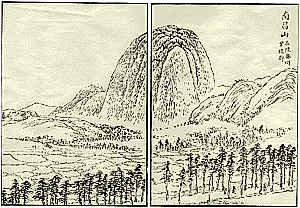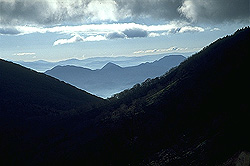In the mountain range lining the right bank of the Kitakamigawa is a group of volcanoes older than Mt. Iwate that date to the end of the Tertiary period between 13 and 25 million years ago. They feature a line of sharply-pointed peaks. Kenji was fond of these ridges, which are essentially volcanic necks.
Volcanic necks are pillars of solidified lava, the remnants of old, weathered volcanoes, or so-called volcano fossils. Let's hear how Kenji explained it.
My friends, in short, volcanic necks are fat rock pillars that are poking their necks up a little from the earth's crust. The neck, you see, is a mountain. Here is a volcano. It spews lava. The lava rises up in a large pillar from deep inside the earth's crust. Little by little the volcano declines and its belly cools off. The pillar of lava hardens. Then over a long period of time the volcano crumbles, worn down by the air and the water. At last, after being planed and shrunk down, it ends up entirely without a top, and all that's left is the hard pillar of lava.
Mt. Nansho seen from Mt. Sankaku
(Photo provided by Hiroshi Okuda)
"When the Oak Tree Professor Slept Outside," from The Complete Works of Miyazawa Kenji,, Vol.6, Chikuma Bunko
 A drawing of Mt. Nansho from Nihon Meisan Zue ("a picture book of famous japanese mountains") |
"Volcano Necks in a Row"Mountains where the Lotus Sutra should be buried.
To the west are Hakoga and Doguga Forests
hat bowl, Nansho, Azumane
Old volcanic necks lined up in a row
Noon and an exquisite, fragile mist of ice crystals
(end omitted)
"Literary Poetry Drafts" from The Complete Works of Miyazawa Kenji, Vol.4, Chikuma Bunko
Today Miyazawa Kenji would be called a naturalist. In "When the Oak Tree Professor Slept Outside" there is a part of the story in which the mountain relates its history to the main character. The story is an example of major themes that run through Kenji's works: the character who comes to hear the voice of the mountain in the process of geological investigations, and living in harmony with nature.
In Kenji's notebook there is a list of mountains where, after his death, he wants [his family] to bury the Lotus Sutra. While the list includes well-known mountains like Mt. Iwate and Mt. Hayachine, the overwhelming number are small, nameless mountains. Today there is a call from many quarters for the preservation of satoyama, or the forested areas that lie between villages and nearby mountains. Kenji cherished these satoyama, almost as if he foresaw this. The list in Kenji's notebook of mountains or locations near mountains where he wanted the Lotus Sutras to be buried are: Numa Forest, Mt. Shinogi, Mt. Iwa, Mt. Atago, Choga Forest, Doguga Forest, Mt. Onigoshi, Mt. Kuromori, Uenohira, Mt. Azumane, Mt. Nansho, Mt. Omori, Mt. Happo, Mt. Matsukura, Mt. Ezurikomori, Mt. Dogazawa, Sennintoge, Mt. Tabashine, Mt. Komagata, Mt. Iwate, Komagatake, Mt. Himekami, Mt. Rokkoushi, Mt. Hayachine, Mt. Keito, Mt. Gongendo, Mt. Tane, Monomizaki, Old Mt. Ten, Mt. Goshi, Mt. Kan'non, Iide Forest.

